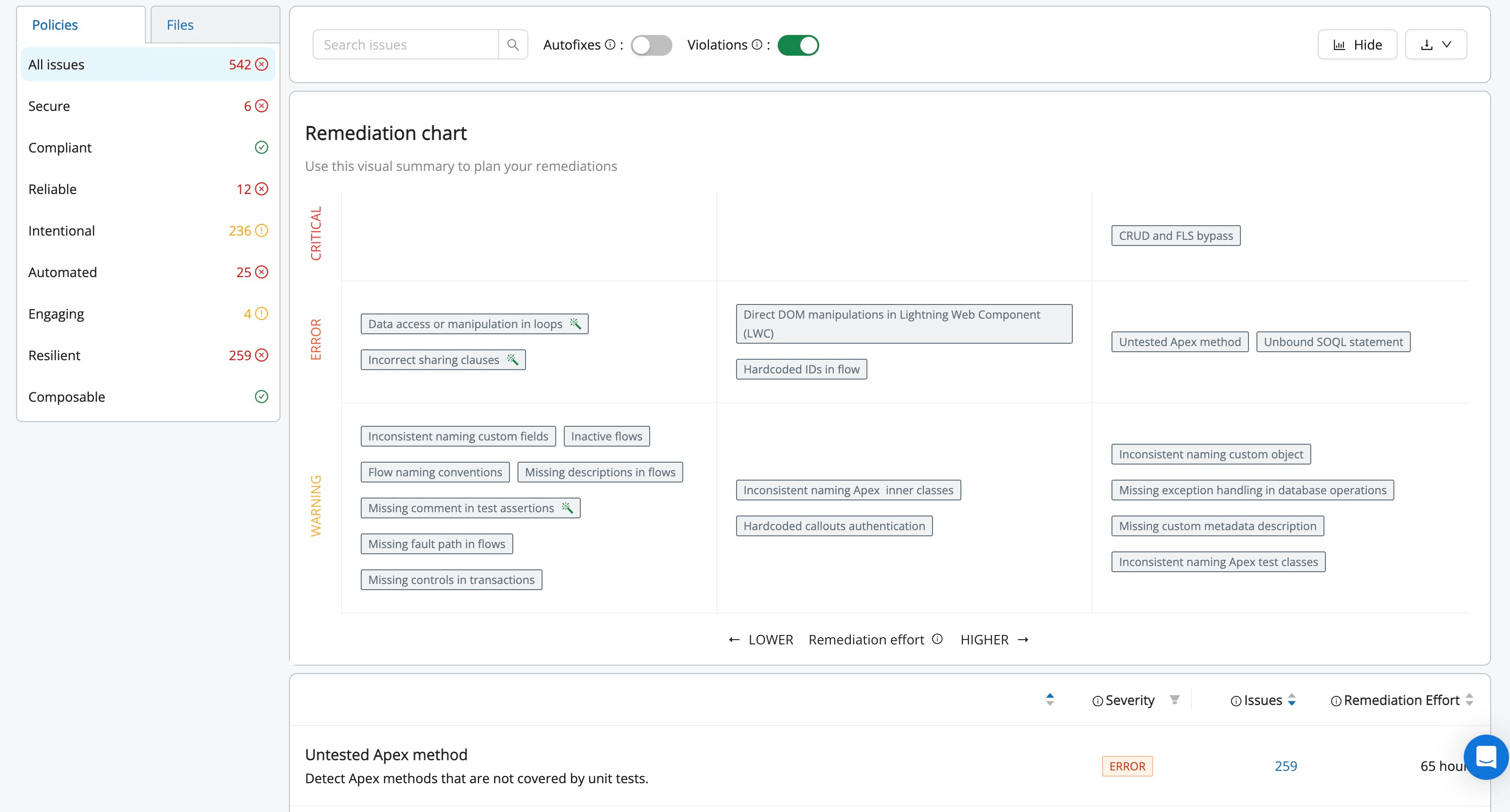Technical debt accumulates in every active Salesforce org through quick fixes, changing business requirements, and system evolution. The key question isn’t whether you have debt, but how much and where it’s causing problems.
In Salesforce’s declarative environment, debt spans clicks as well as code — from suboptimal admin configurations that slow page loads to outdated automation patterns running in parallel with newer Flows. When deployment failures spike, governor limits hit their ceiling, or a simple field addition takes three days, you know debt has moved from an abstract concern to an operational crisis.
In this post, we’ll cover Salesforce’s native basics for identification and assessment and then show how Gearset’s DevOps platform adds advanced detection, analysis, and remediation to turn technical debt into clear, actionable work.
Understanding the Technical Debt Ratio (TDR)
The Technical Debt Ratio (TDR) measures how much it would cost to fix existing issues compared to what you’ve spent building the system in the first place.
In Salesforce terms, that means comparing your estimated remediation cost (for bugs, inefficient code, or configuration fixes) against the total development cost of the same feature or project over a defined period — typically a release cycle or fiscal year. TDR = (Remediation Cost / Development Cost) × 100. So if your Salesforce org costs $500,000 to develop and resolving identified issues would cost $50,000, your TDR is 10%.
In practice, you’ll want to keep your TDR below 10%, with 5% being a strong indicator of healthy development practices. Anything above 20% is a warning sign that debt is dragging down delivery.
These thresholds aren’t arbitrary: a 23% TDR on your budget can mean $34,000 per quarter lost to avoidable rework — and that cost translates directly into developer hours where you could’ve been building new features instead of fixing old ones.
A typical example of remediation times could include:
- Simple field deletion: 5 minutes
- Flow refactoring: 4 hours
- Trigger rewrites: 2 days
- Major architectural changes: 40+ hours
This two-way translation is what makes TDR actionable. Dollar figures get executive attention and justify investment. But hour-based estimates make technical debt work backlog-ready. When you size technical debt work in hours — whether it’s a quick field deletion or a multi-day architectural change — those issues can slot into your backlog alongside features.
With a shared currency of developer time, your product owner can weigh “fix the governor limit warning” against “build new lead scoring,” turning the conversation from opinion to clear trade-offs.
Building your Technical Debt Registry
Once you’ve calculated your Technical Debt Ratio, the next step is to make that debt visible and actionable. That’s where a tech debt registry can help. Filling in these details can help you understand the impact to the business and where you should focus your efforts first:
- Issue description: Clear, specific problem statement
- Categories: For example, Apex / Flows and automation / Configuration / Integration / Security
- Business impact score: 1–5 scale
- Remediation hours: Estimated fix time
- Risk level: Critical/High/Medium/Low
This framework converts the findings from static code analysis, org health scans, and configuration checks into work items your team can pick up and resolve as part of their regular delivery cycle.
Score the business impact of an item of technical debt by asking three questions:
- Does the issue affect user productivity?
- Could this debt item cause data loss or security issues?
- Will it block future development?
Rate 1–5 based on severity and user count. A broken automation disrupting lead assignments for 500 sales reps is a bigger deal than a page layout issue that only three admins ever see.
Turn the registry into quarterly budgets with: Total Remediation Hours × Average Developer Rate = Cleanup Investment. Then weigh this against the cost of doing nothing.
What are the native Salesforce options for measuring technical debt?
Salesforce does provide some built-in ways to surface tech debt in your orgs. Salesforce Optimizer, once the go-to tool for highlighting unused metadata and performance concerns, has now been retired. The main native option today is Salesforce Code Analyzer, which runs static analysis across Apex, Flows, and Lightning code to uncover quality, security, and performance issues. It’s powerful for spotting problems in both declarative and programmatic logic, but on its own it doesn’t provide a full picture of technical debt across the org.
Setup Audit Trail tracks recent administrative modifications in your org. You can view the 20 most recent changes directly in the UI, and download up to 180 days of history via CSV. This delivers forensic visibility into who changed what and when, which is useful for accountability and debugging sudden issues. But, Setup Audit Trail stops short of giving you broader insight into data changes, component dependencies, actual usage patterns, or the business impact of those changes.
Salesforce Code Analyzer is Salesforce’s solution for scanning both programmatic and declarative code. Unlike Optimizer’s metadata-level checks, Analyzer inspects real code quality, security risks, and performance issues across Apex, Visualforce, Flow, and Lightning components.
Flow Scanner, which is part of Code Analyzer, is especially relevant as organizations migrate from Process Builder to Flows. Flow Scanner reviews Flows for:
- Inefficient loops that hurt performance
- Poor error-handling practices
- Resource-heavy operations likely to hit limits
- Conflicting automation patterns
On its own, Code Analyzer tells you what’s wrong, not how to fix it. It flags issues but doesn’t provide the context or dependency analysis needed to act safely. Without a complete picture of how components connect, refactoring a “problematic” trigger might break managed packages or integrations — turning cleanup into a source of risk.
This leaves a gap between detection and action. While native capabilities serve their purpose for basic scanning, DevOps teams need to move from identifying problems to fixing them safely and efficiently. For teams managing technical debt at scale, Gearset bridges this gap by providing dependency analysis, remediation guidance, and automated fixes that turn detection into action.
Technical debt measurement, built into the DevOps lifecycle
Unlike Salesforce’s native tools, which stop at detection, Gearset is built to measure, prioritize, and manage technical debt across the entire DevOps lifecycle. Because it’s a complete DevOps platform, Gearset combines static code analysis, dependency mapping, remediation guidance, and automated fixes — turning abstract problems into structured, backlog-ready work.
With Gearset, you’re not just collecting a list of issues; you’re measuring debt in the same currency as feature delivery: remediation hours, business impact, and team velocity. This makes it easier to quantify the cost of debt, justify investment, and track steady improvement over time.
Measuring debt with Code Reviews
Gearset’s Code Reviews give you a structured way to measure technical debt across Apex, Flows, Lightning Web Components, Visualforce, and Aura. Each issue is classified by severity (critical, error, warning) and assigned an estimated remediation effort, so you can calculate the cost of debt in hours and prioritize accordingly.
The Remediation Chart makes this visible: issues are grouped by rules, plotted by severity and fix time, and surfaced in Git branch reviews or org assessments. That visualization helps teams quickly identify “quick win” fixes versus long-term remediation projects — a practical input into a Technical Debt Registry or Technical Debt Ratio calculation.
By pairing effort estimates with severity levels, Code Reviews turn abstract quality concerns into measurable debt items. You can slot them into your backlog alongside features, report on remediation hours, and track progress release by release.

Making technical debt visible with Org Intelligence
Measuring technical debt starts with visibility. You can’t calculate fixing costs or build a Technical Debt Registry if you don’t know what’s actually in your org, how it’s connected, or how hard it will be to change. Salesforce’s native tools surface some issues, but often stop short of providing the context you need to size and prioritize them. But Gearset’s Org Intelligence can help.
Org Intelligence maps your org’s architecture, showing the entire metadata, dependencies, and permissions structure, so you can see exactly how fields, Flows, automations, and components connect. Instead of relying on partial “Where is this used?” checks, you get full impact analysis — complete with history of who made changes and when. That context makes it possible for any developer to be dropped into any org and have complete clarity on what exists and why. It also highlights unused fields, ghost code, and redundant automation, giving you a backlog of debt items to quantify.
Beyond surfacing debt, Org Intelligence helps share org knowledge. Insights are available to every team member, not locked into one or two experts. This spreads context, reduces “people debt,” and makes estimating and planning debt remediation a collaborative process rather than a bottleneck.
Alongside Org Intelligence sits the Gearset Agent, which can interpret org complexity in plain English. You can type prompts like “Why is this page running slow?” or “How do I automate this safely?” and get guided answers, with AI-generated cleanup suggestions. This blends human control with AI speed, turning technical debt from an opaque risk into clear, measurable work.
Move from detection to action with Gearset
Gearset’s enterprise DevOps platform bridges the gap between knowing you have technical debt and doing something about it. Where native Salesforce tools highlight problems, Gearset gives you the context, safeguards, and automation to fix them safely and sustainably. From Org Intelligence mapping out dependencies, to Code Reviews with autofix and quality gates, to safe deletions and instant rollbacks, Gearset turns cleanup into part of your delivery rhythm rather than a risky side project.
Start your free 30-day trial today, or book a personalized demo to see how to partner with Gearset to prevent new debt, remediate legacy issues with confidence, and build continuous quality into every release.



